AC Milan beat Roma 3-1 at San Siro in the first game of the second half of the Serie A season to extend the points gap between the two teams to 13, and pad the gap to fifth place to nine points.
Yacine Adli scored his first goal for the club in the 11th minute to put the home side ahead. Oliver Giroud doubled the lead in the 56th minute after Milan benefitted again from positioning a player (Simon Kjær) at the far post at the second phase of a corner kick – adding more weight to this being a specific set piece ploy.
Roma pulled one goal back from the penalty spot with just over twenty minutes of regular time remaining. But Theo Hernández ensured there was no repeat of last season’s fixture, where Milan let a two goal lead slip, by powering home a third for the Rossoneri in the 84th minute to secure the three points.
This fixture ultimately proved to be José Mourinho’s last game in charge of the Giallorossi with the experienced Portuguese coach having since been relieved of his managerial duties.
Here to provide his observations on how both Stefano Pioli and Mourinho appeared to approach the game from a tactical perspective is @Tactics_Tweets.
Set-ups
Milan operated from a back four system in all phases of play, with Davide Calabria and Theo Hernández flanking Simon Kjær and Matteo Gabbia.
Yacine Adli, Tijjani Reijnders and Ruben Loftus-Cheek occupied central midfield areas, with Loftus-Cheek often more advanced than his two teammates, both in and out of possession. Oliver Giroud led the forward line with Christian Pulisic attacking from the right flank and Rafael Leão from the left flank.
For Roma, they operated from a back five system, with three midfielders ahead and Stephan El Shaarawy closest to Romelu Lukaku up front. Out of possession their shape can be best visualized as a 5-3-2 but when attacking this transitioned into more of a 3-5-2, with both wing-backs getting forward to provide the team width.
Game plans
Neither team’s gameplan veered too far away from their usual respective styles of play. Although there were some noticeable aspects in how each side intended to attack and defend against the other.
From a Milan perspective, in build-up phases Pioli’s side tended to split into two units to ultimately try and disconnect the Roma 5-3-2 defensive block. The deeper unit consisted of the back four, Adli and Reijnders, and the advanced unit was made up of the three forwards and Loftus-Cheek slightly lower, in pockets of space between the lines.
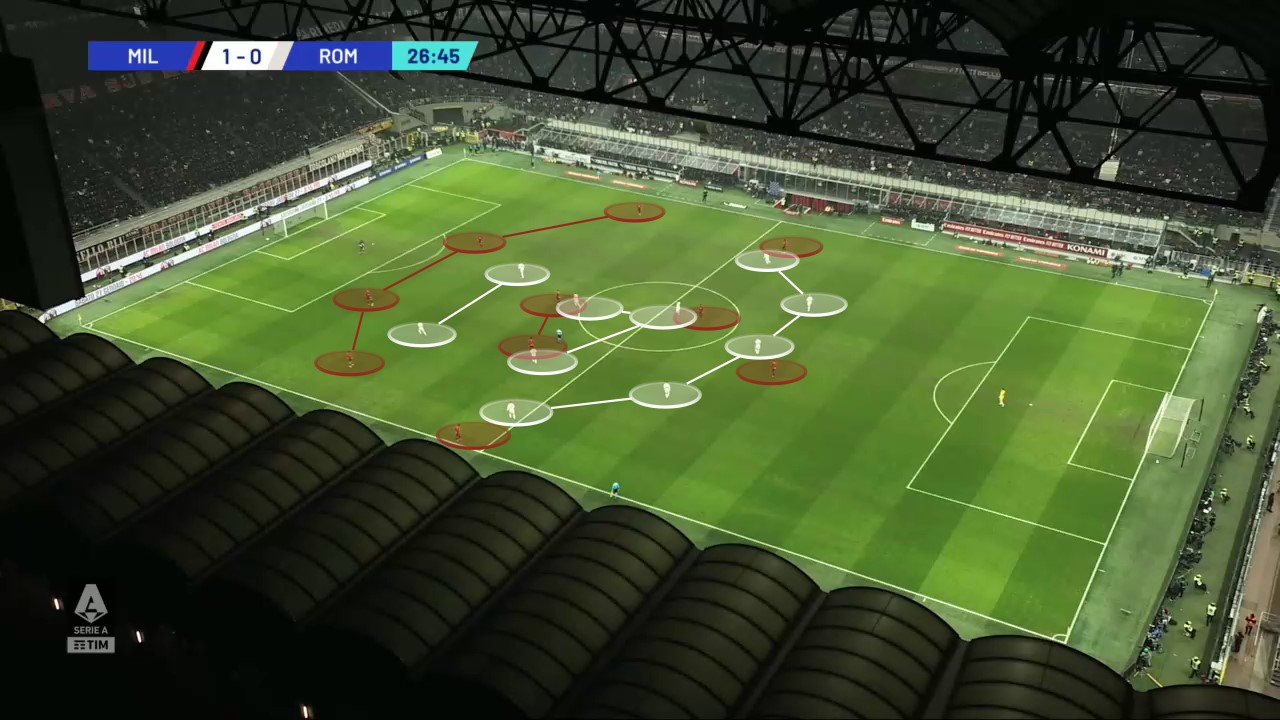
The deeper build-up unit was tasked with drawing out the Roma forward and midfield lines (disconnecting these players from the back five in the process) in order to 1) bypass it and progress possession upfield and 2) create space for the advanced build-up unit against the (ideally disjointed) opposition backline.
Once Milan reached the final third, as the Roma 5-3-2 collapsed towards their own box, the home team all squeezed up the pitch to sustain attacking possession sequences. Kjær and Gabbia sat deepest with Adli, Reijnders and the two full-backs ahead.
This quartet supported, and joined, attacks whilst also ensuring elements of rest defence were maintained (e.g. protecting against counterattacks).
In defensive phases, Milan switched between a player-orientated high press which dropped into a more zonally focussed low block. Against settled Roma possession, Milan tended to sit in a medium block (which resembled a 4-2-3-1 visually) and involved allowing an underload in their forward line which afforded an overload in their backline.
Whilst Leão had a relatively simplified role out of possession (in its simplest terms, staying goal side of Rasmus Kristensen), certain Milan players had more complex responsibilities to help maintain the team’s organisation between their high-to-medium-to-low defensive shapes.
The intention behind these hybrid defensive schemes appeared to be being adaptable in maintaining coverage against Roma’s 3-5-2 wing-back system whilst reducing the risks of leaving the backline isolated (e.g. in 1v1 situations). This approach produced upsides and downsides, as we’ll come onto.
From a Roma perspective, in possession, like Milan, the away side aimed to use deep build-up, and a deeper positioning of their players, to disjoint the home team’s defensive structure. The ultimate aim was to isolate the Milan backline (ideally) in 1v1 situations e.g. Lukaku up against one centre-back or an advanced wing-back against an opposition full-back.
Roma’s main methods of implementing this were – 1) rotations and overloads in central areas to try and manipulate and disorientate the Milan marking scheme and 2) diagonal switches of play to the Milan weak side for a wing-back in space.
Out of possession, as mentioned, Mourinho’s men operated out of a 5-3-2 formation. During Milan’s deep build-up phases, the Roma midfield line pushed up to support their two forwards in engaging the ball, with the ball-side wing-back also jumping to help provide coverage in wide areas if needed. However, this unit of players was quite ineffective in performing this task, as we’ll see shortly.
As Milan progressed into the opposition half and into the final third, the Roma team dropped into a 5-3-2 low block which aimed to protect their box and get lots of players in between the ball and the goal. Although, this tactic didn’t prevent Adli from scoring from the edge of the area despite having multiple bodies in front of him to make it 1-0.
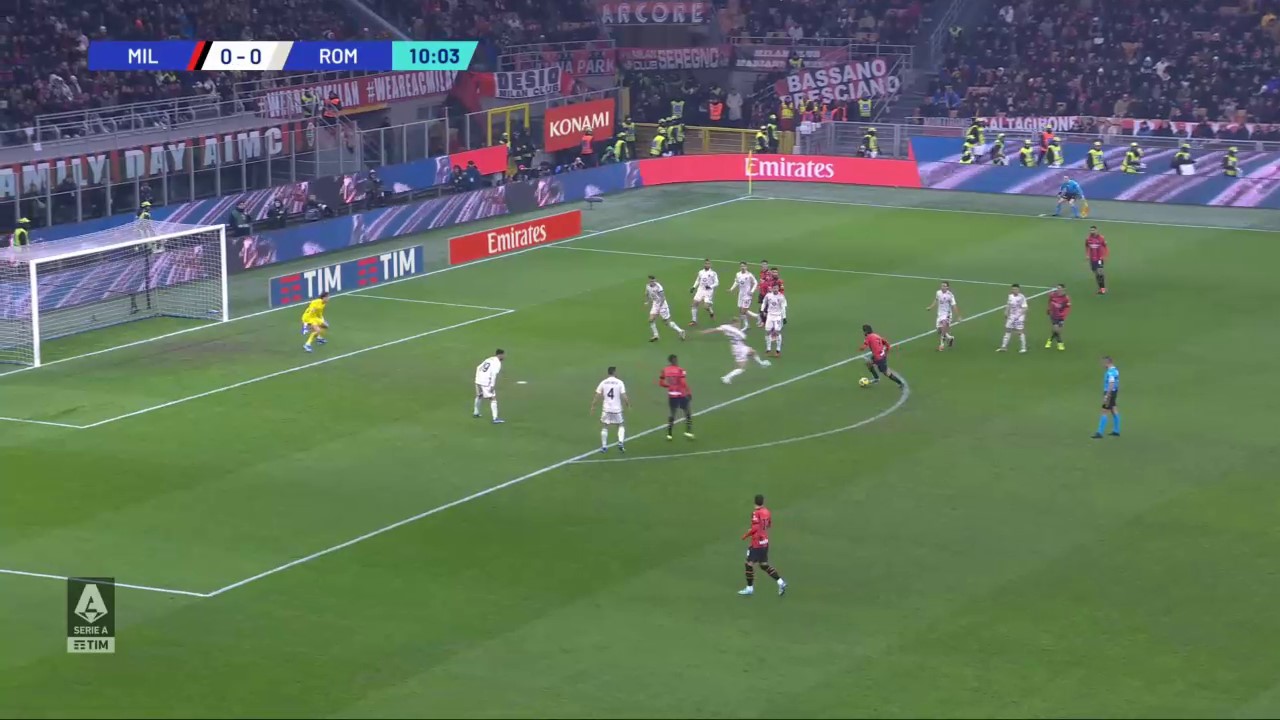
With overviews and context of both team’s gameplans now provided, let’s dive into some specific tactical aspects.
Build-up ‘exits’
As detailed above, Milan had specific plans in build-up phases to progress possession and create attacks. Their plan involved using their 4-2 substructure which included positioning their full-backs wide and playing Adli and Reijnders as a double pivot.
The number of players in this substructure (six) created a numerical advantage against Roma’s forward and midfield lines (five players) which helped Milan bypass these opposition players and progress upfield.
When Roma pushed another player forward to equal the numbers, typically a wing-back, then this helped disjoint their backline and create space for Milan to attack into.
Pioli’s instruction to his full-backs to maintain width also helped increase the distances the Roma forward and midfield lines had to cover (this substructure is narrow by nature).
The upsides this provided Milan were they could drag the Roma players across the pitch which not only would have been physically tiring but also helped create spaces elsewhere e.g. on the opposite side of the pitch or even new gaps centrally caused from any Roma disorganisation.
Throughout the ninety-minutes Milan executed, and benefitted from, these build-up plans frequently. A key feature of their play was how often (and easy at times) they could ‘exit’ their build-up phase and progress possession into the opposition half and/or final third specifically using their full-backs.
Here are some examples in practice which showcase both effective Milan play and ineffective Roma organisation and/or execution starting in the 5th minute. This sequence began with a backwards throw-in to the Milan deep build-up unit of six which attracted the Roma forward and midfield lines. Spot Loftus-Cheek in between the lines too.
This passage initiated on the Milan left flank and to make it difficult for the narrow 3-2 Roma substructure, the hosts switched play to the opposite side (right flank) to Calabria in space.
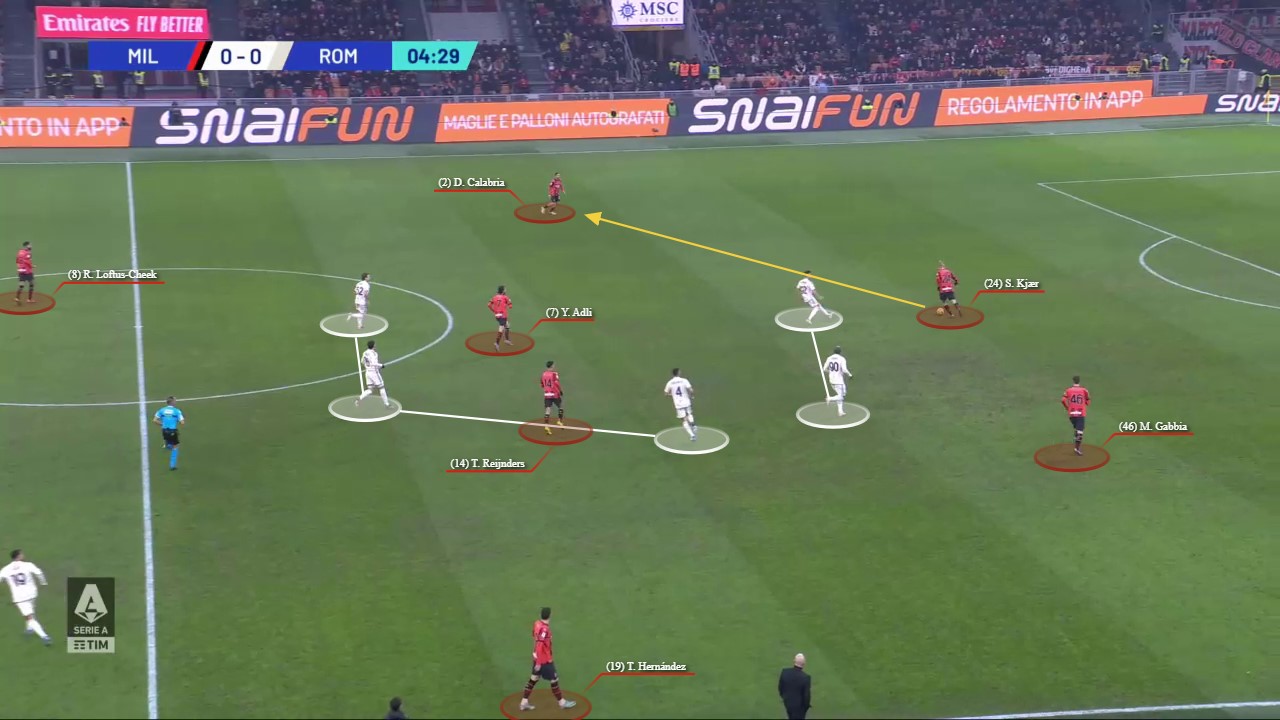
With the ball-side Roma midfielder having too much distance to cover to get out to Calabria, Leonardo Spinazzola’s (left wing-back) job was to jump and engage but he reacted late, and also had too much distance to cover, so an easy forward pass was made to Pulisic on the right wing.
As Spinazzola was now also upfield, Diego Llorente (left-sided centre-back) had to push out wide to close down Pulisic.
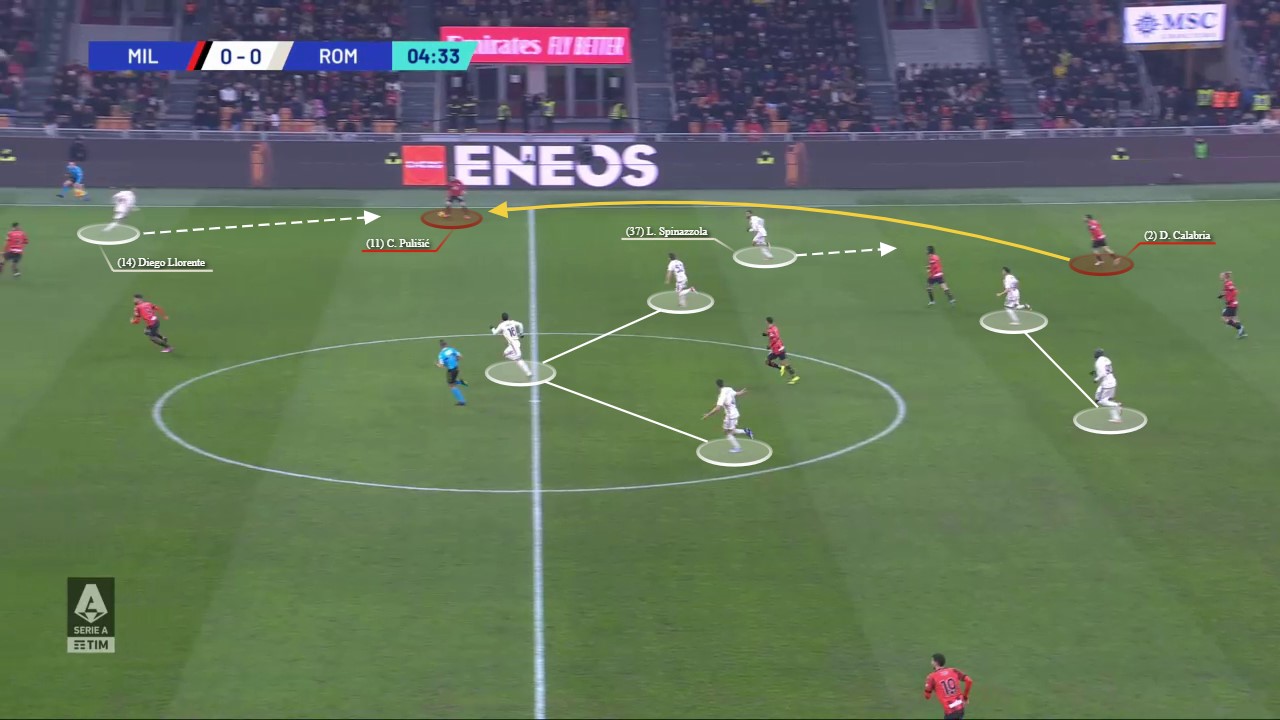
Despite this attack being prevented with Edoardo Bove retreating and tackling (see below), in this sequence you can witness multiple upsides of Milan’s plan.
The hosts had been able to; 1) initially bypass five Roma players using a full-back ‘exit’, 2) disconnect the Roma overall defensive team structure, 3) disjoint the backline and create space to attack into (a potential 3v3 situation had been created in this instance).
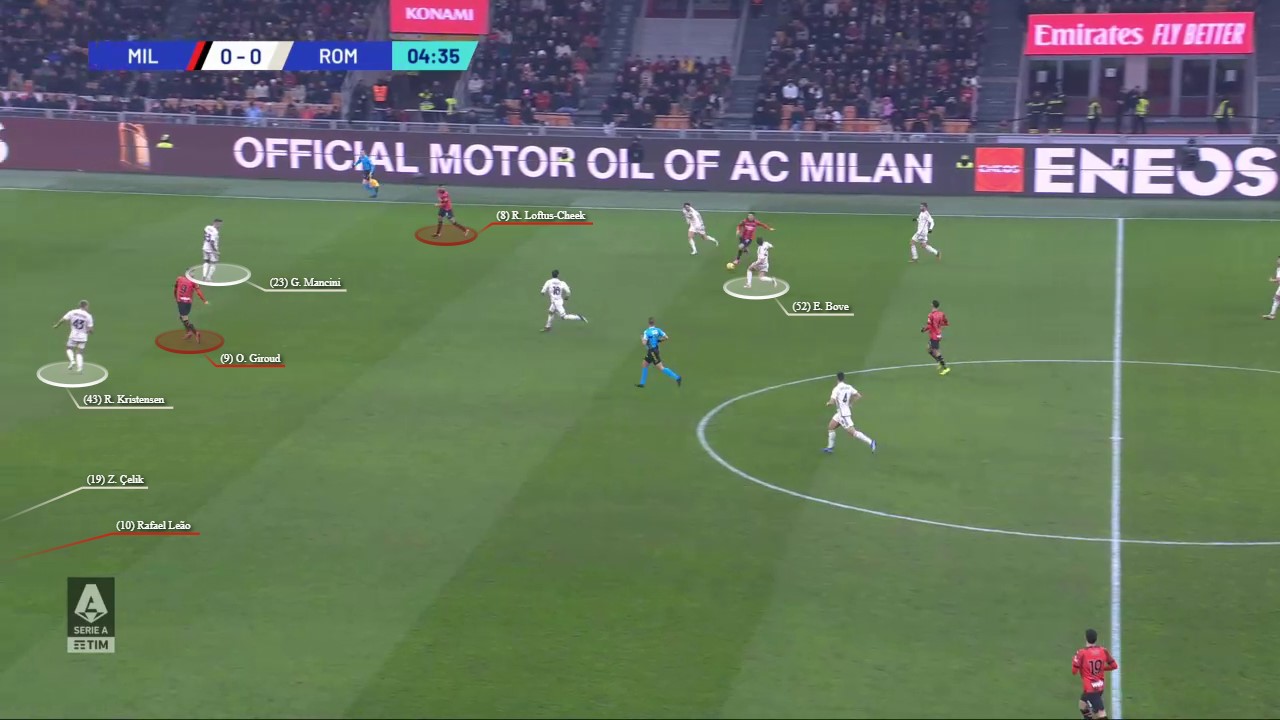
There was another example of Milan exiting their build-up phase using a full-back and the upsides this generated in the 9th minute.
Milan had worked possession back towards their own goal to draw Roma higher and then the home team began to play out via their left-hand side to draw Roma over to that side of the pitch.
As you can see below, the potential pass to Hernández drew up Zeki Çelik (right wing-back). In this instance, Leandro Paredes sat deeper to cover the more advanced Loftus-Cheek.
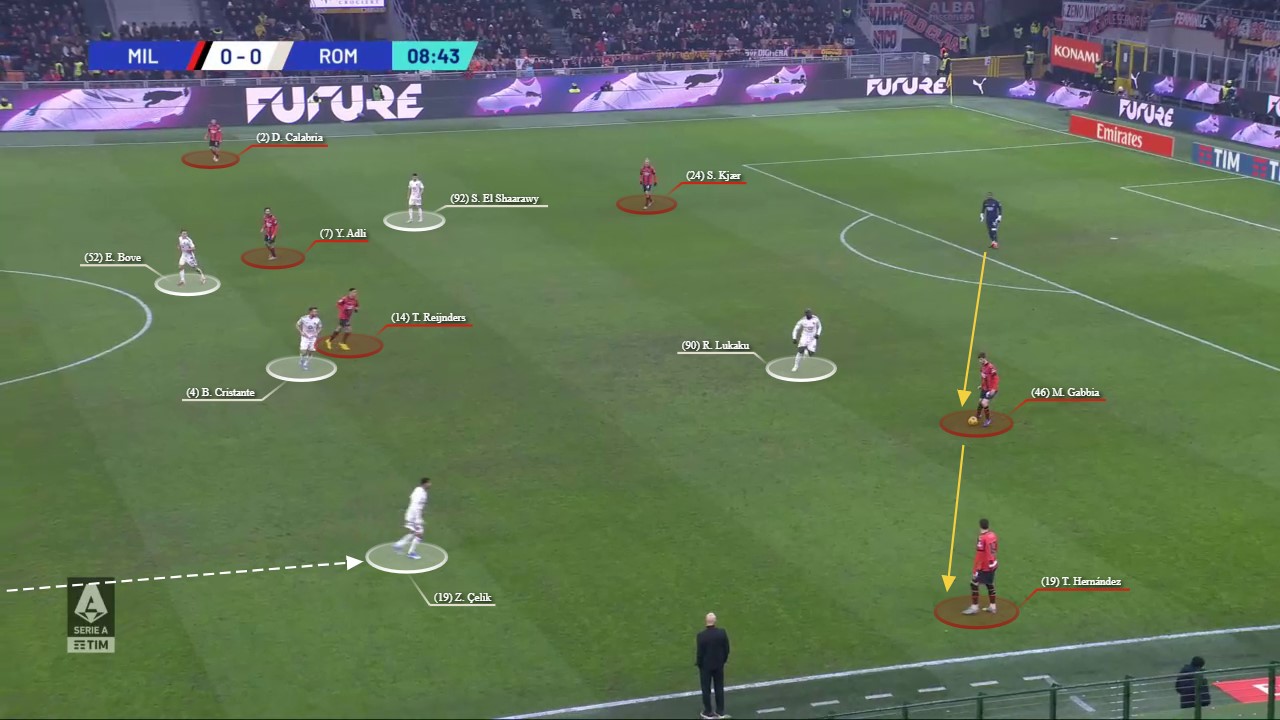
True to form, after drawing Roma over to one flank Milan aimed to manipulate the opposition block by switching the point of their attack. First they passed into the middle and then towards the right flank where Calabria was in space.
His diagonal off-ball movement infield had opened up a passing lane through the lines which helped bypass five Roma players and exit this phase.
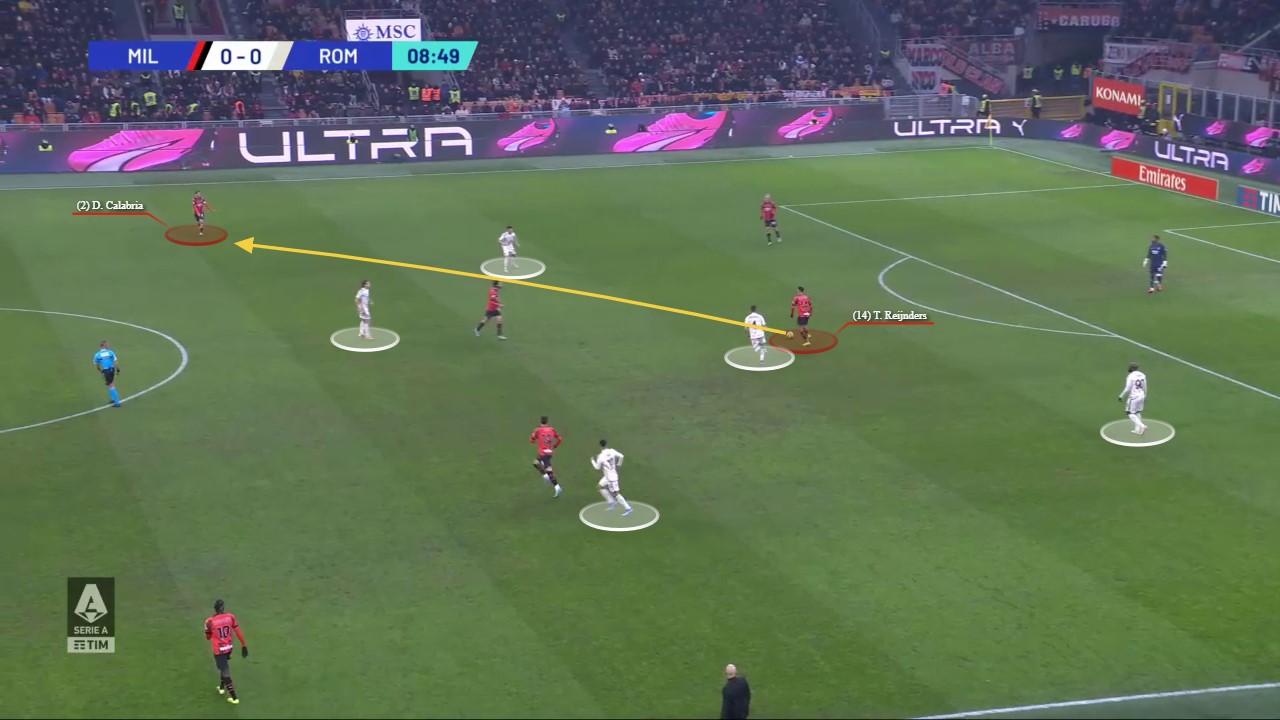
After receiving the ball, Calabria carried possession deep into the Roma half unopposed before passing out wide to Pulisic. Below you can see the now disjointed Roma backline of five (white line) and how this has helped create spaces for Milan to potentially exploit.
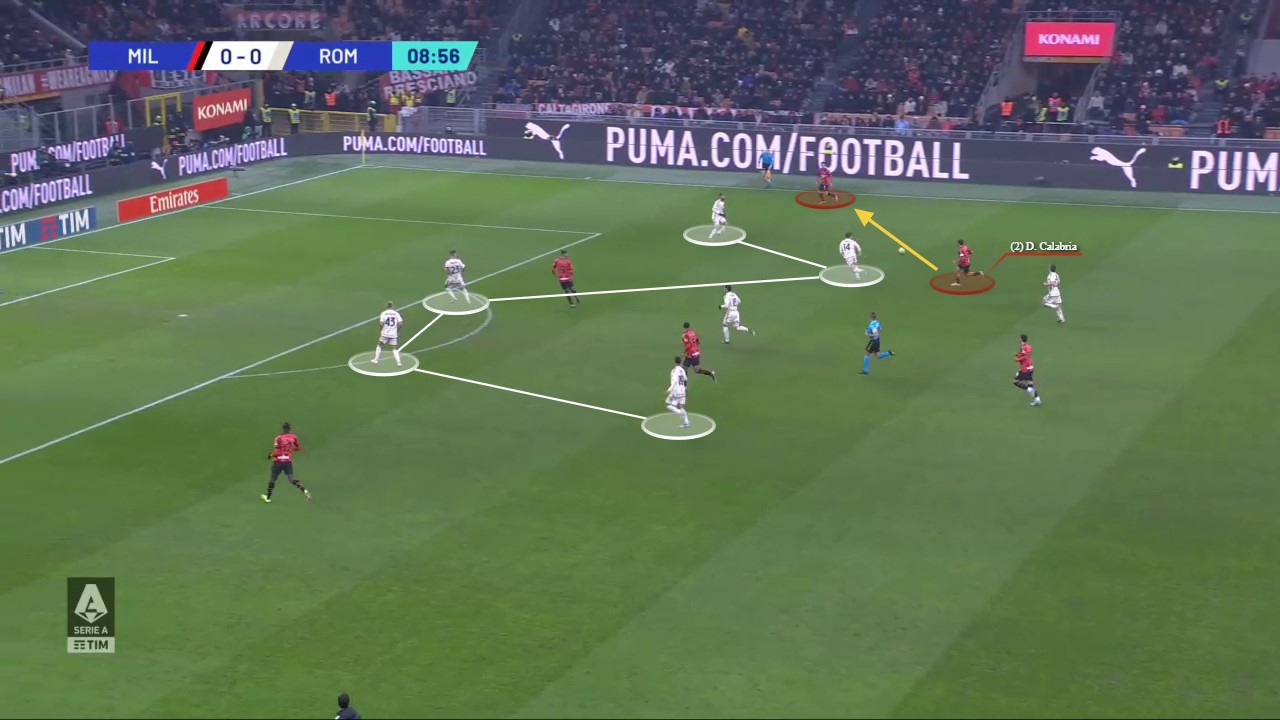
In this action, Pulisic passed across the edge of the area but the ball managed to avoid the advanced Hernández and then Leão’s attempted back-heel pass to Loftus-Cheek ended up conceding possession back to Roma.
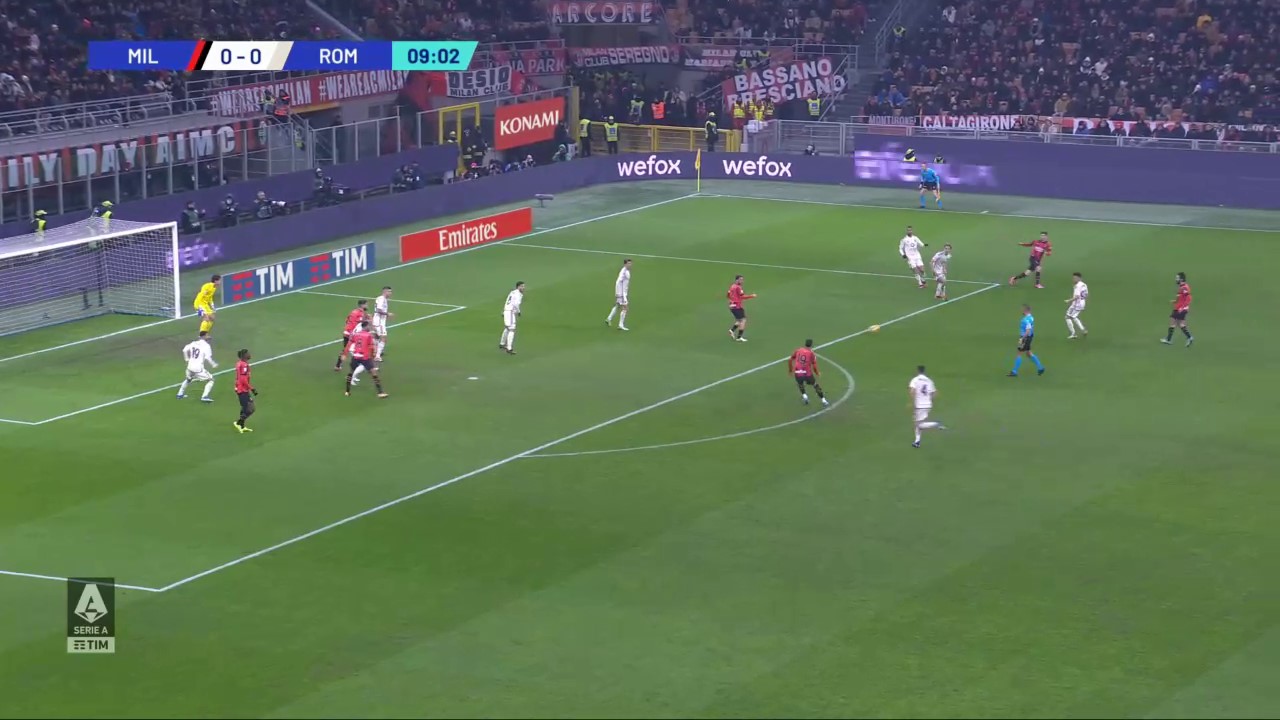
Just before the half hour-mark Milan generated a shot on goal using their now familiar build-up tactic and full-back exit strategy.
Calabria was again the outlet and his receipt of the ball drew out Spinazzola which determined the right-backs next decision. On cue, a forward pass was made to Pulisic in the knowledge he would initially be in space on the right wing and there would then be an opportunity for Milan’s forward players to attack a disjointed Roma back five.
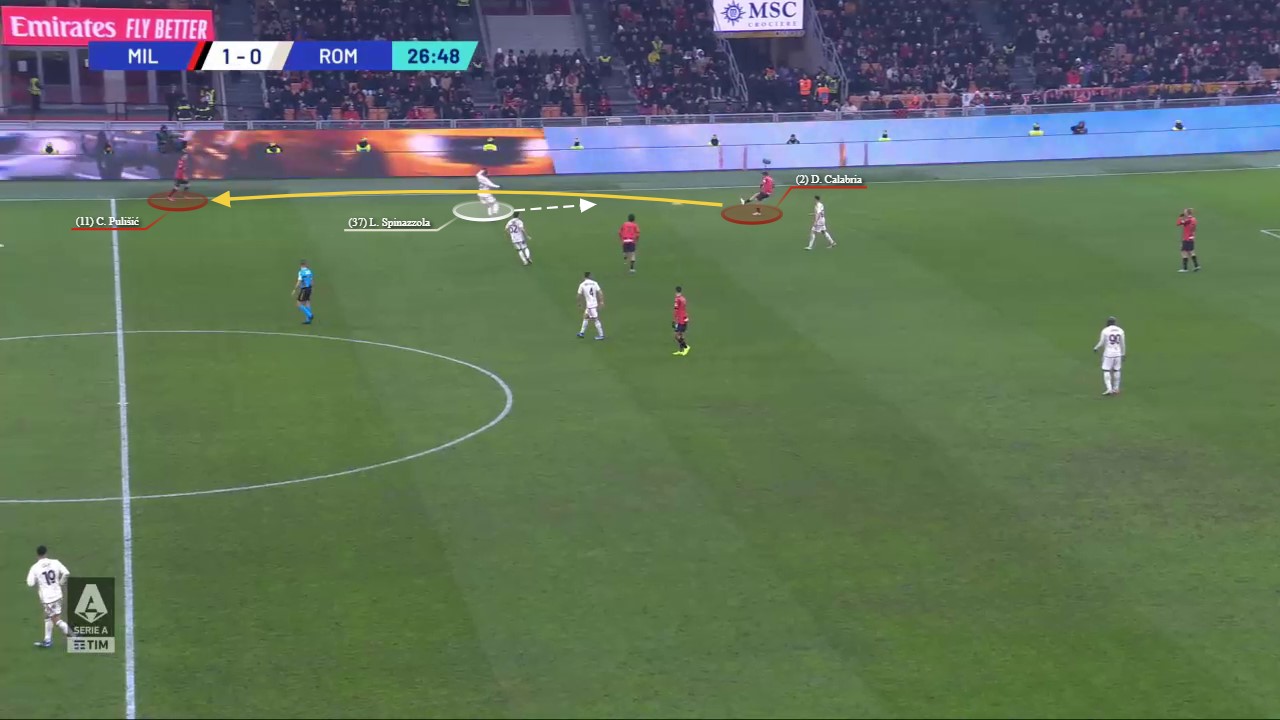
Once Pulisic received the ball, Giroud and Loftus-Cheek further helped disjoint the Roma backline (white circles indicate the remaining three players in the back five) by making opposite movements.
Pulisic and Giroud combined to execute a one-two which enabled the USMNT international the opportunity to run at goal and get a shot on target.
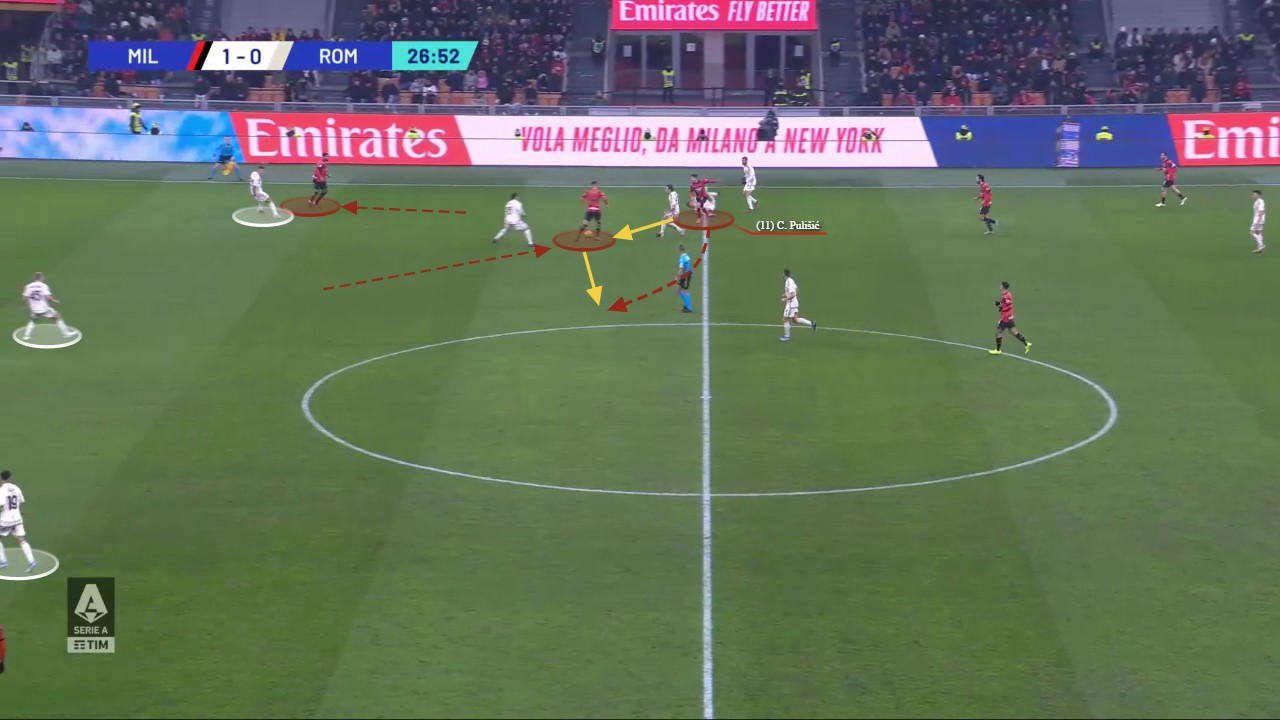
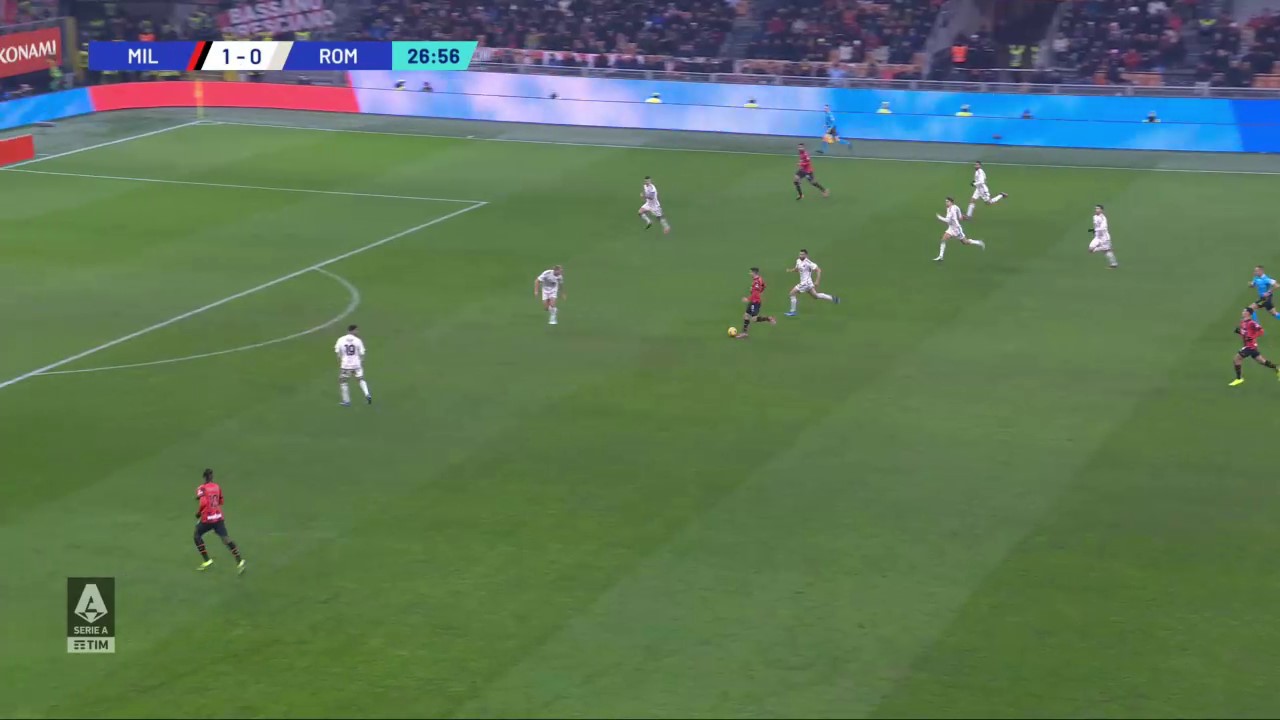
There were examples of this tactic in the second half too. Here, late in the 49th minute, the passage of play starts with Milan working the ball backwards to draw Roma upfield. Below you see the two team’s respective substructures.

Milan combined on their left-hand side which attracted the Roma players towards the ball and as such, the Rossoneri could find an exit and progression opportunity via Calabria on the right.
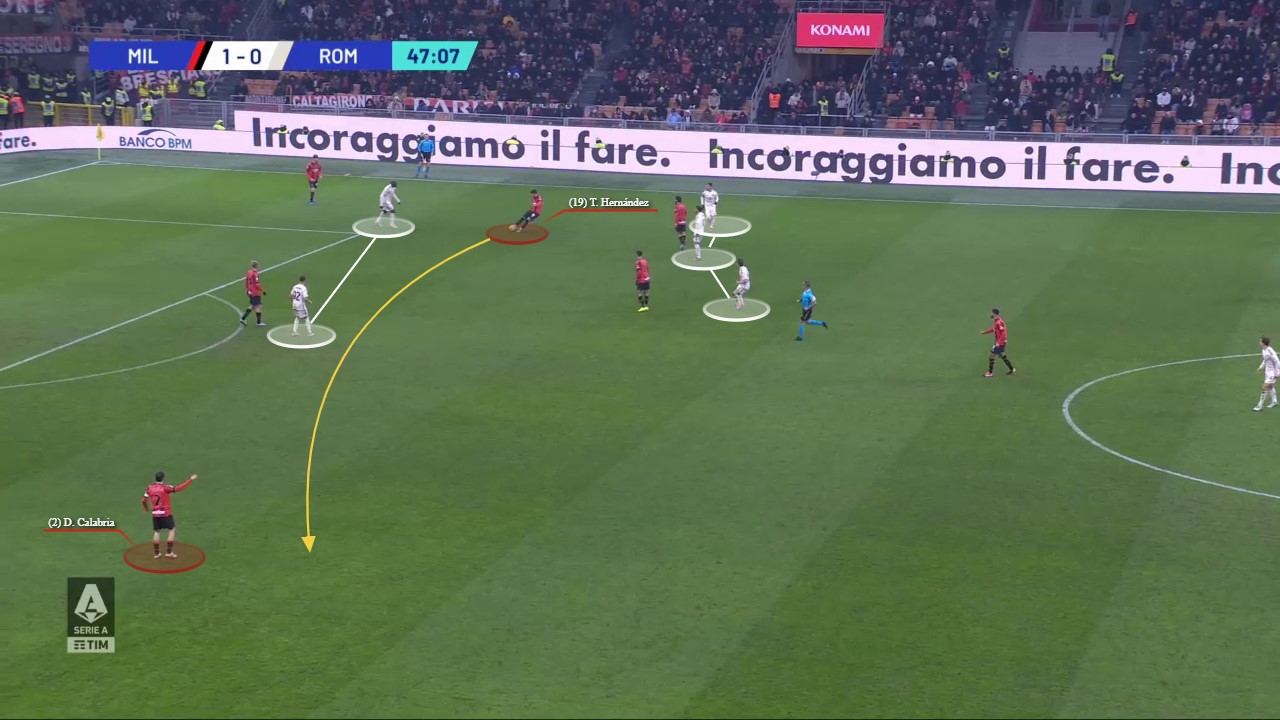
Shortly after receiving the ball, the Milan right-back carried towards the final third where he passed out wide to Pulisic. From here, Milan worked the ball inside where it ended up with Reijnders who sliced his shot high and wide.

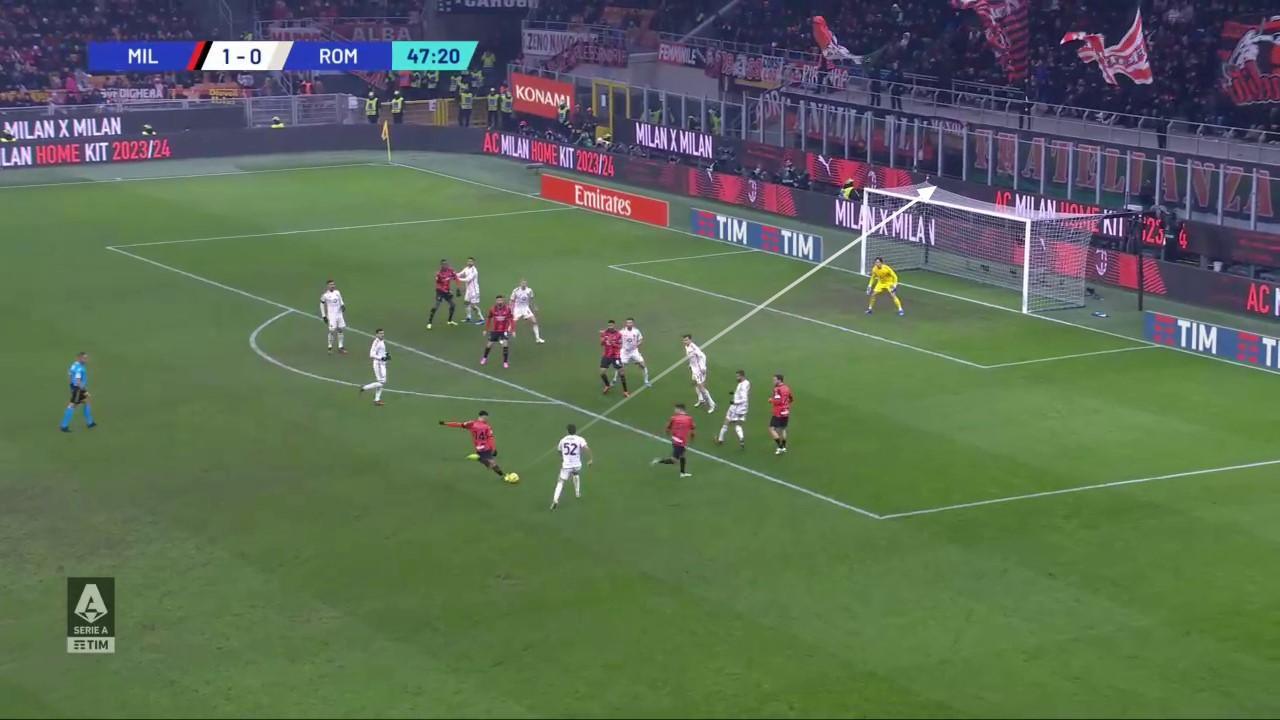
Even though these build-up tactics did not lead directly to any of Milan’s goals, the examples shown and the others throughout the game provide context as to how Milan intended to find joy against Roma.
And whilst Milan did also use Hernández in their build-up exits, Calabria was very much the protagonist in this aspect of play. As the graphic from @markrstats shows below, the Milan right-back ranked highest on the pitch for Ball Progression via a Carry and second highest for Ball Progression via a Pass.
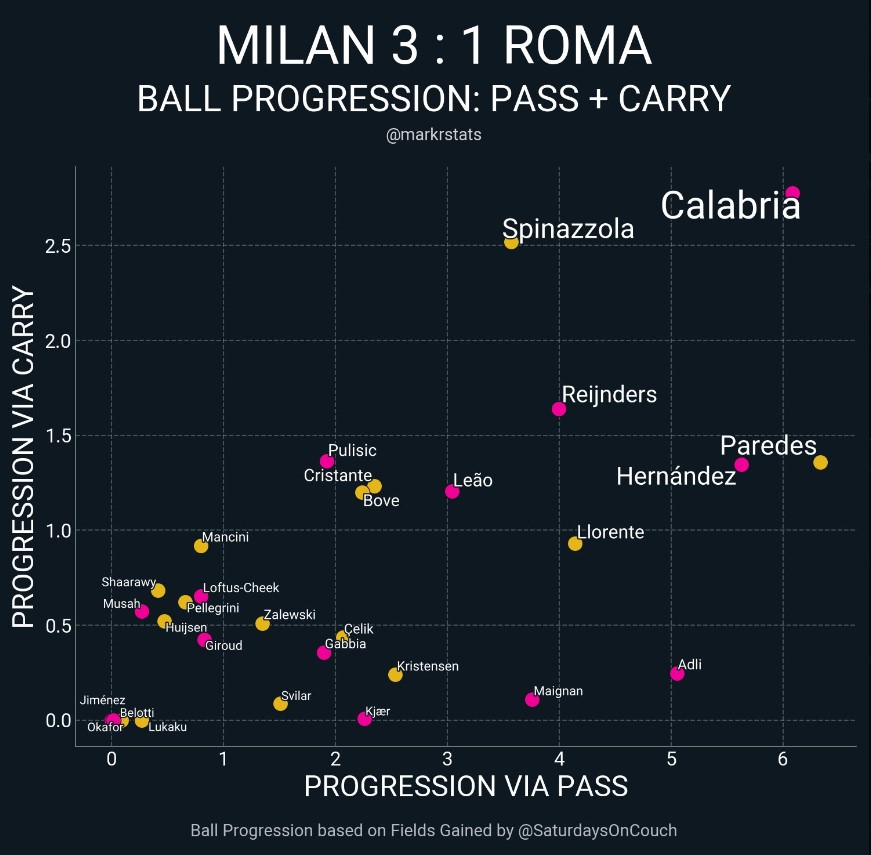
Hybrid defensive scheme
Another interesting aspect of Milan’s approach was their hybrid defensive scheme. As already explained, in defensive phases, Milan switched schemes when defending high, medium (middle) or low. Within the wider team structure, individual players and units also had complexities to their roles to deal with Roma’s attacking system.
The main intention of this hybrid approach appeared to be maintaining adaptability so Milan could be dynamic and proactive out of possession – which they were on occasions.
However, there were trade-offs and downsides with this plan and whilst these did not get exposed fully (nor punished) by Roma, they are worth highlighting.
Starting with the positives, Milan’s player-orientated high press helped force 8 high turnovers, two of which led to shots on goal. But in fact, Milan’s high press played its part in two of their goals.
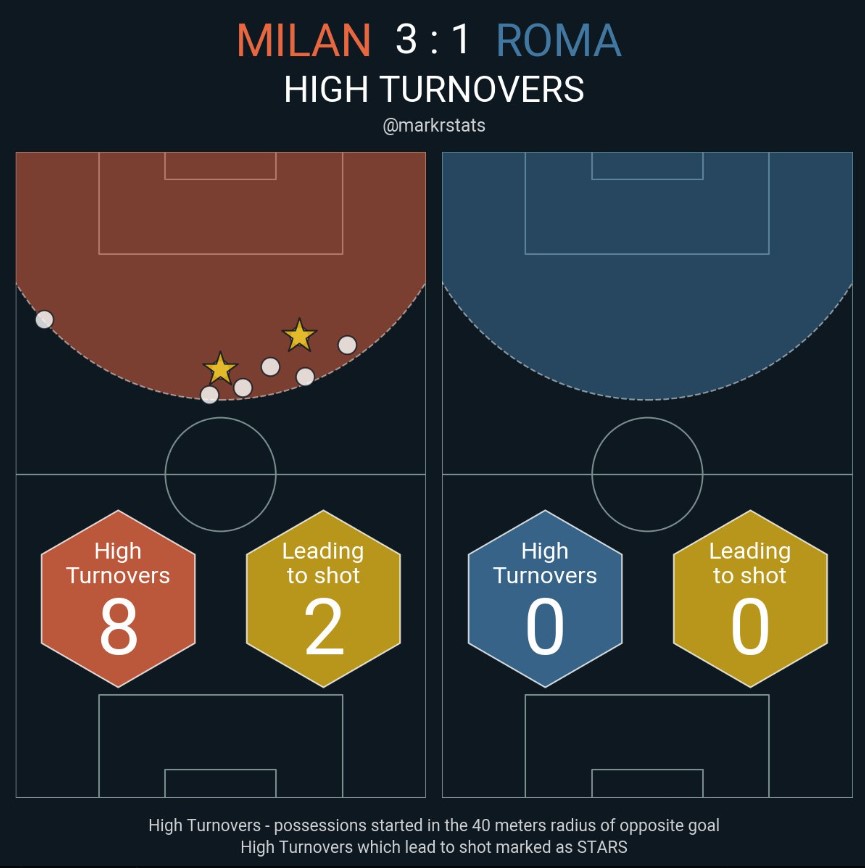
In the 10th minute, Roma had a goal kick which they played short. Below you can see the Milan player-orientated high block set in position with the three Milan forwards each initially covering one of the back three.
Roma had positioned their wing-backs and two midfielders deeper in this build-up phase, in an attempt to bait the Milan players higher up the pitch, potentially leaving their backline exposed.
However, Milan’s hybrid approach meant they were prepared to initially allow an underload in forward areas so they could maintain an overload (coverage) in their backline. As a result, in the instance below, Loftus-Cheek is in between two opponents. When the ball was passed out left to the free Spinazzola, Calabria jumped to engage.
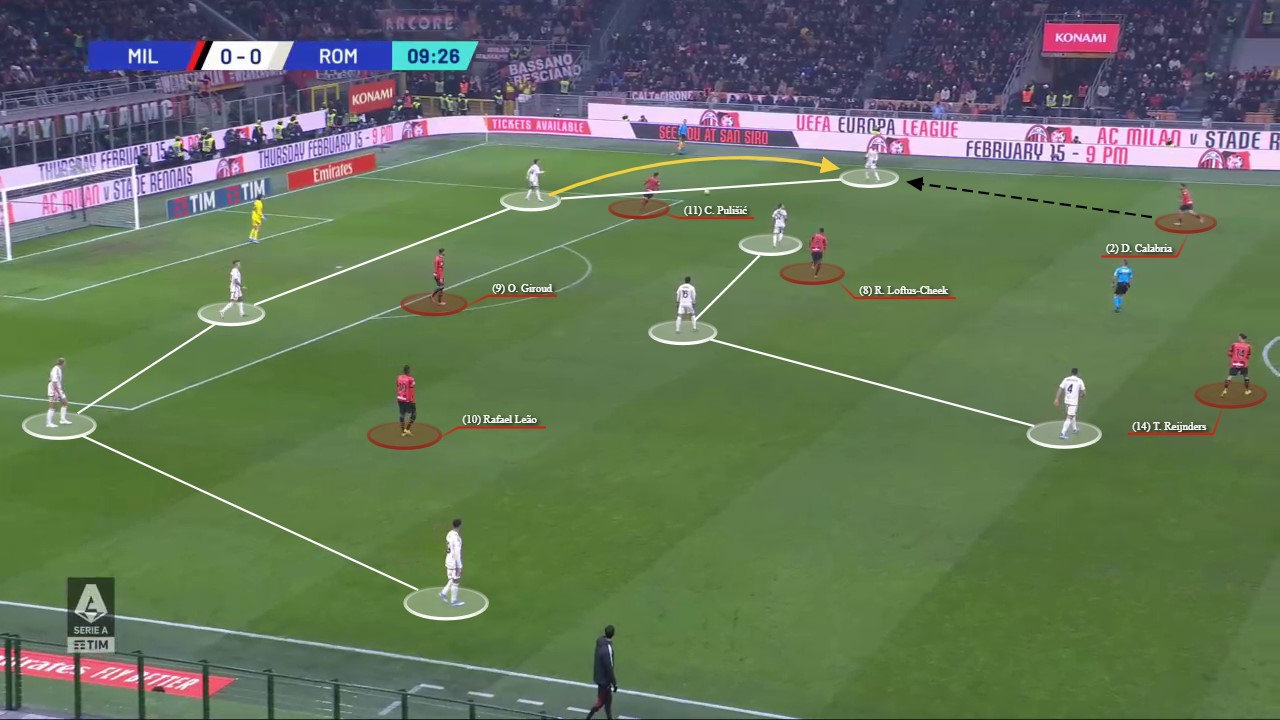
Although Calabria’s engagement lacked intensity, the Milan hybrid scheme kicked into action and the system helped force a turnover. In the image below, you can now see Adli (previously out of shot) marking El Shaarawy.
The reason for this is two-fold: 1) it allowed Calabria to jump to engage the Roma wing-back and 2) it allowed the two Milan centre-backs to stay deeper and focus on creating a 2v1 against Lukaku.
However, with Adli not able to help mark one of Roma’s midfielders, the away side (in theory) had an overload opportunity. Milan’s solution for this was for Loftus-Cheek to track the ball-side midfield option (Bove in this specific instance) and Giround dropped to cover the now free Paredes.

Milan therefore were able to lock onto all Roma players on the ball-side, whilst still protecting against any direct long balls into Lukaku, and as a result, forced a turnover which 35 seconds later resulted in Milan going 1-0 up.
The corner kick which led to Milan’s second goal also came about from a high turnover from a Roma goal kick – albeit a poor one from Mile Svilar. Nonetheless, Milan’s ability to switch into a more player-orientated focus when defending high helped provide positive outcomes.
A similar scenario to the one above repeated itself in the 26th minute. Roma again played short from a goal kick and towards the left flank.
Milan were set in their high block / press system – Pulisic jumped to engage Llorente, Loftus-Cheek picked up Bove, Giroud dropped to cover Paredes and Calabria jumped to engage Spinazzola.
However, like the first instance, Calabria was slow to reach the Roma wing-back and he therefore had time to play a long direct aerial pass…

…towards Lukaku. Whilst Spinazzola’s pass lacked accuracy, Milan were also covered by the fact their hybrid approach in advanced areas allowed for them to maintain a 2v1 coverage against the Roma target man. This was also aided by the fact that Adli was picking up El Shaarawy in this phase of play.
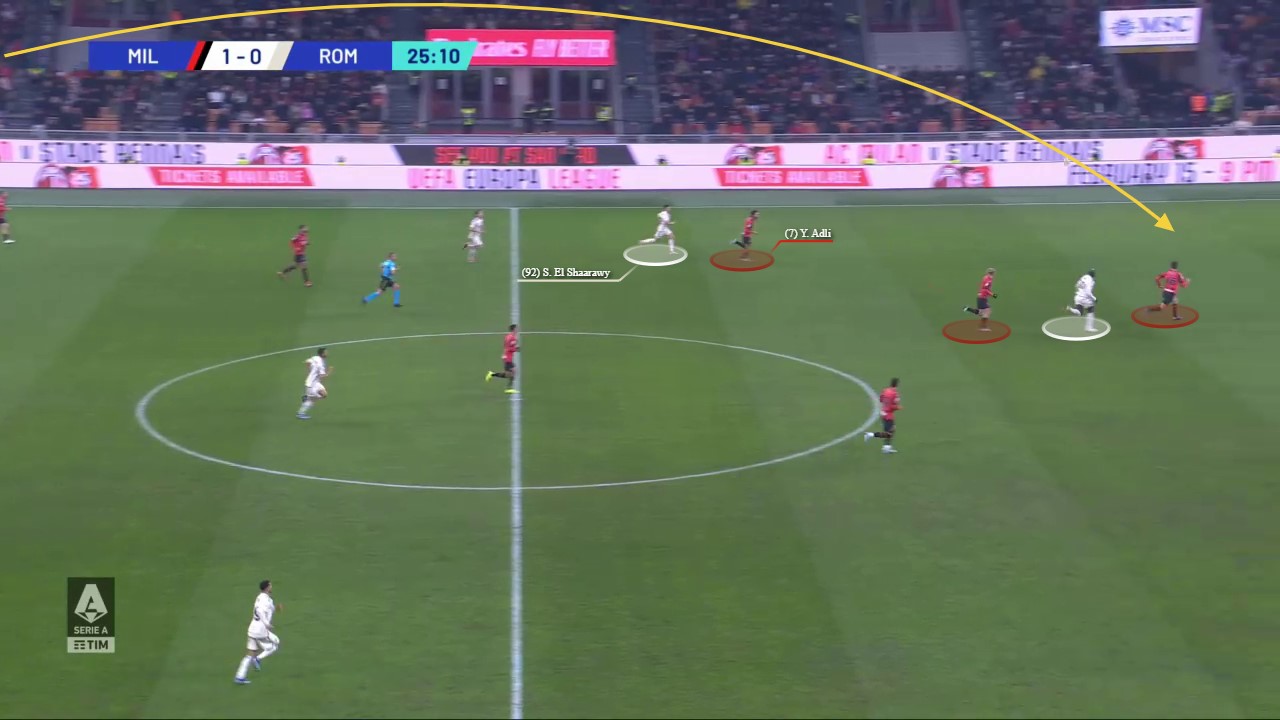
But Milan’s hybrid approach was also intended to benefit the team across all defensive phases. Here’s a passage of play starting in the 13th minute which illustrates some of the upsides (and complexities) Milan had by using this tactic.
Roma started the sequence with a freekick which was passed backwards to their back three. Below you can see either side’s respective shape including certain Milan players who are in between two opponents – their different responsibilities – including Giroud tasked with covering Mancini and Paredes, Pulisic with Llorente and Bove, and Loftus-Cheek with Bove and Paredes.
Other Milan players have one opponent to track e.g. Leão, Reijnders and Calabria primed to jump his opposition wing-back. As Llorente was in possession it was the trigger for Pulisic to jump and engage which meant that Loftus-Cheek needed to pick up Bove and Giroud needed to drop onto Paredes.
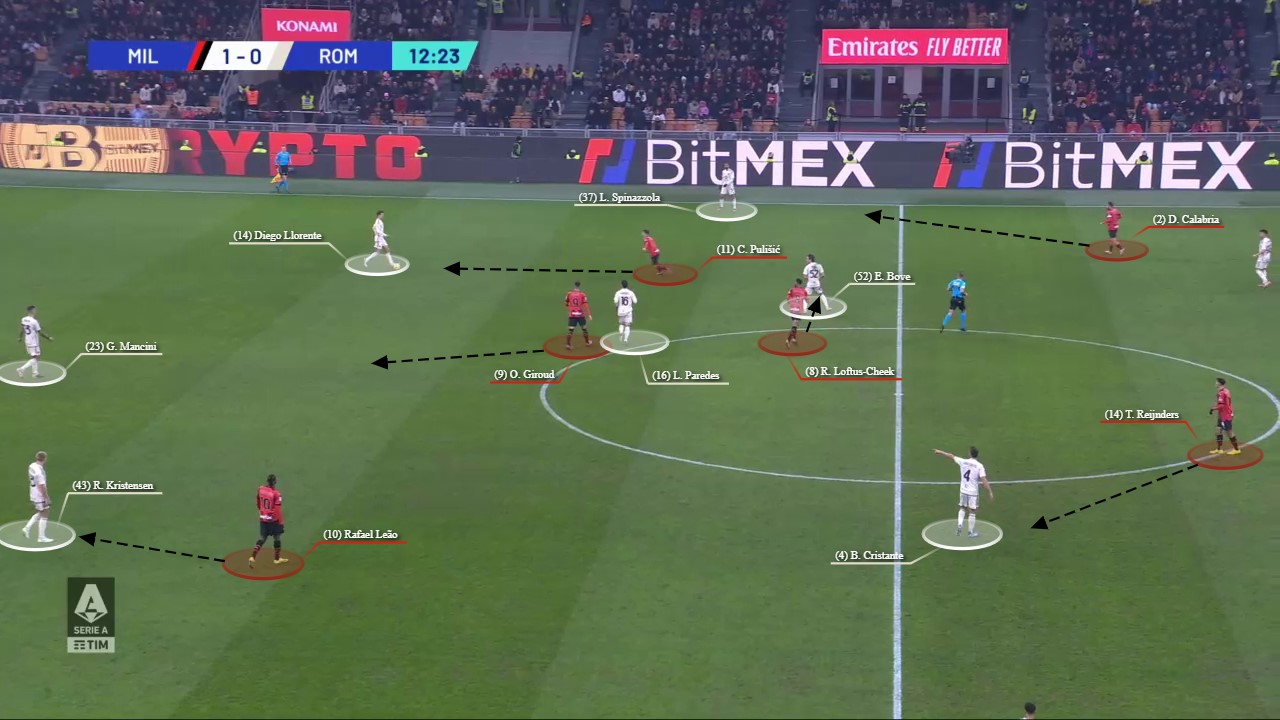
All of the aforementioned actions helped force Roma back towards their own goal but they reset and the ball got to the feet of Mancini so Milan were forced to adjust their roles again. Giroud was now tasked with engaging forward which vacated Paredes (who was advancing forward) so therefore Loftus-Cheek needed to pick him up and this meant Pulisic needed to tuck inside to cover Bove.

As Roma worked the ball over to their right flank, Milan adjusted again. The pass to Çelik was a trigger for Hernández to jump and engage. Notice how Calabria is now out of shot, as he has dropped to provide coverage in the backline to make up for Hernández pushing out of it.
Elsewhere in this action-packed visual, Loftus-Cheek dropped to cover Paredes and Reijnders was closely tracking Cristante’s off-ball (and decoy) forward run. The next Roma pass was in fact inside to Bove who made a lateral movement – on the blindside of Giroud – to receive the ball. Pulisic didn’t track, as at this point Bove in essence became the Roma midfield 6 which meant he was now Giroud’s responsibility.
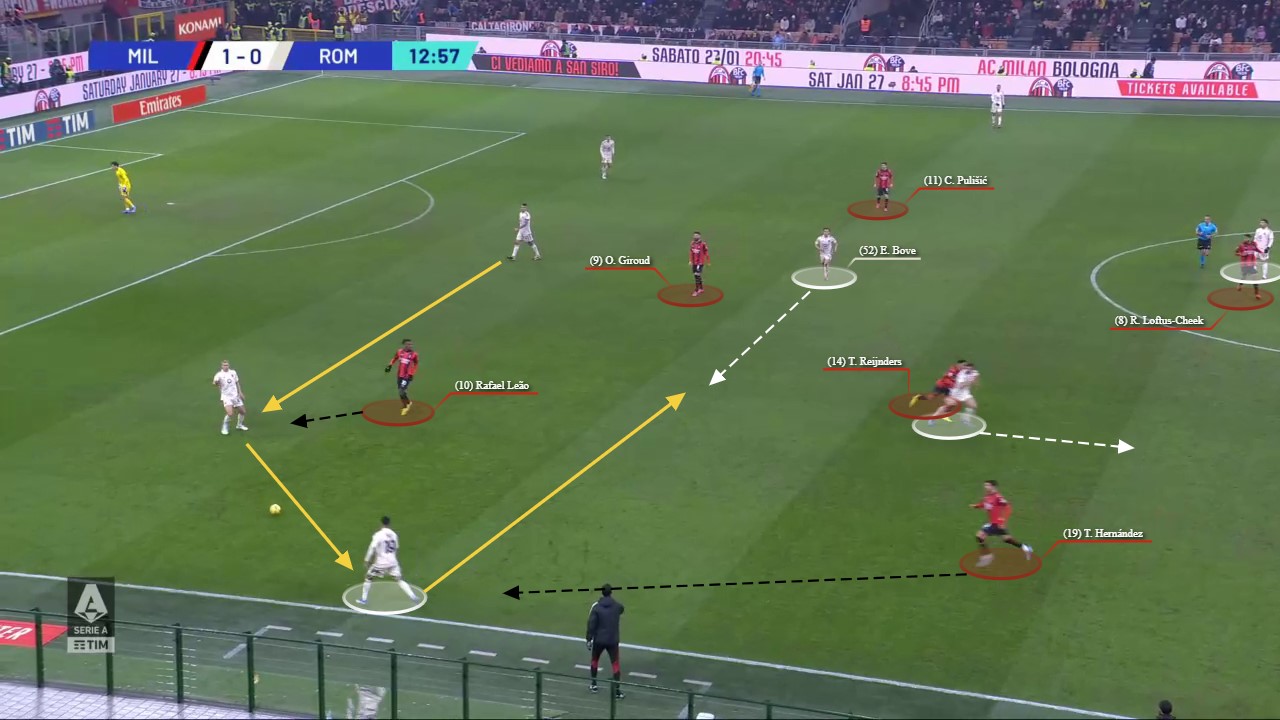
Despite appearing initially late to react, the French striker managed to recover and tackle the Roma midfielder…
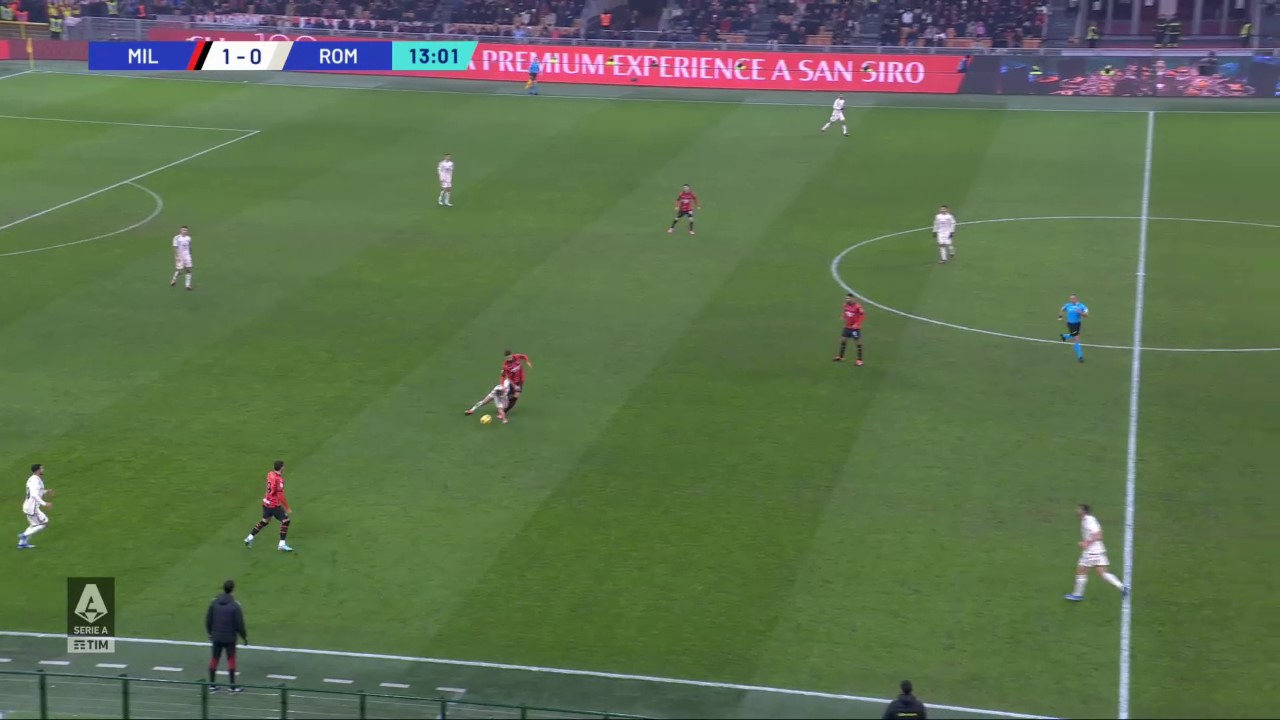
…but the loose ball found its way back at the feet of a visiting player and Roma then looked to spring an attack.
Below you can see how Milan’s hybrid defensive roles in forward and midfield lines helped them not only maintain an overload in their backline but also forced (enticed) Roma to progress via their weak side.
And even though this side was initially exposed, it resulted in Roma attacking laterally / diagonally first which can be used as a delay tactic to give the defending team time to get additional numbers back in retreat – which is what helped Milan defend this eventual situation.
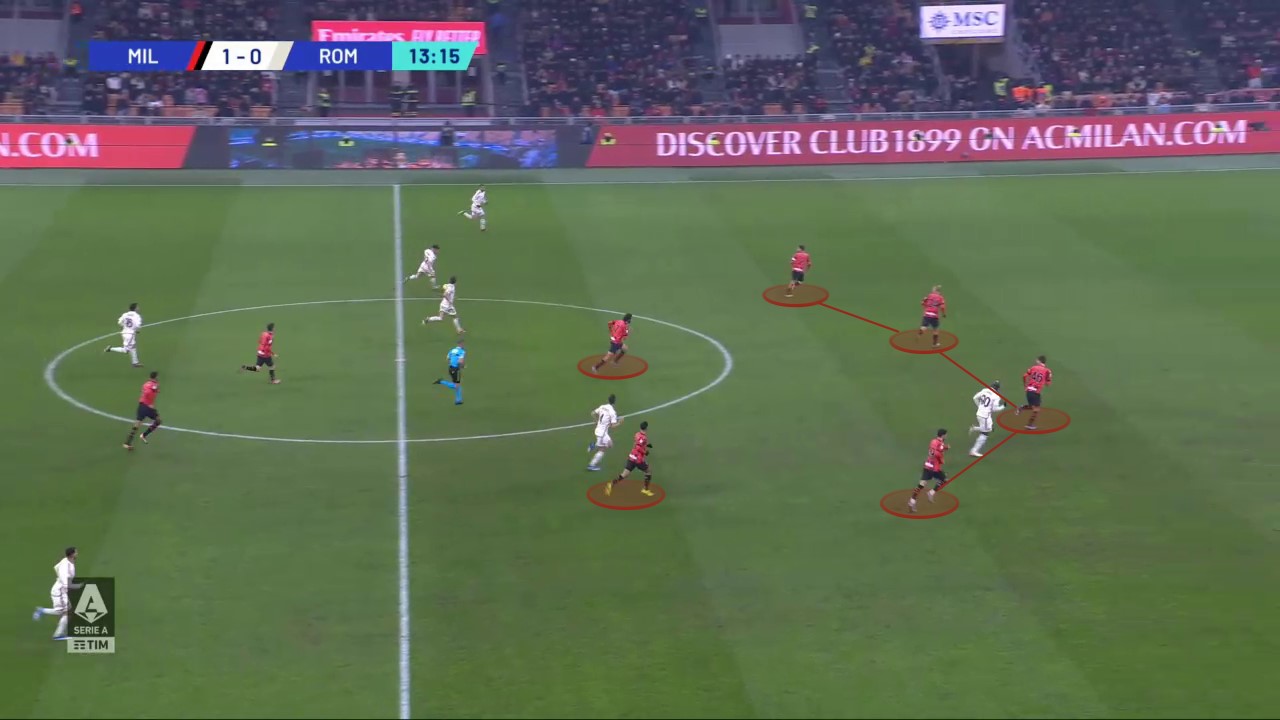
As seen above, on certain occasions Roma attempted to use positional rotations to disrupt Milan’s hybrid marking scheme. The intention was to cause confusion for Milan in terms of who was picking up who.
Then, in moments of hesitation, Roma could find a free player in space who could create an attacking moment. As happened in the 38th minute when Roma were successful in this tactic and it led to a Paredes shot.
But this was not the only trade-off Milan allowed (risked) with their out of possession approach. A couple of examples of the risks are highlighted in @milantactics thread. So whilst Milan’s defensive tactics were effective in moments throughout the game, it would be inaccurate to depict this game as a flawless defensive performance.
Pioli’s side have continued to allow opponents shots on their goal this season – Roma had 12 in total. And according to Wyscout, in 2023/24 Milan have to date averaged 10.96 shots per 90 but allowed 12.18 shots per 90 against.
Therefore, a welcome and deserved three points. But still plenty of work to be done and improvements to be made.
Up next
Next on the slate for Milan is a trip to Udinese on Saturday. The Rossoneri currently have an eight point cushion on fourth-placed Fiorentina.
So with third place consolidated for now, the Milan hierarchy and faithful will be hoping a continuation of this mini winning streak can help reduce the gap to the two at the top.


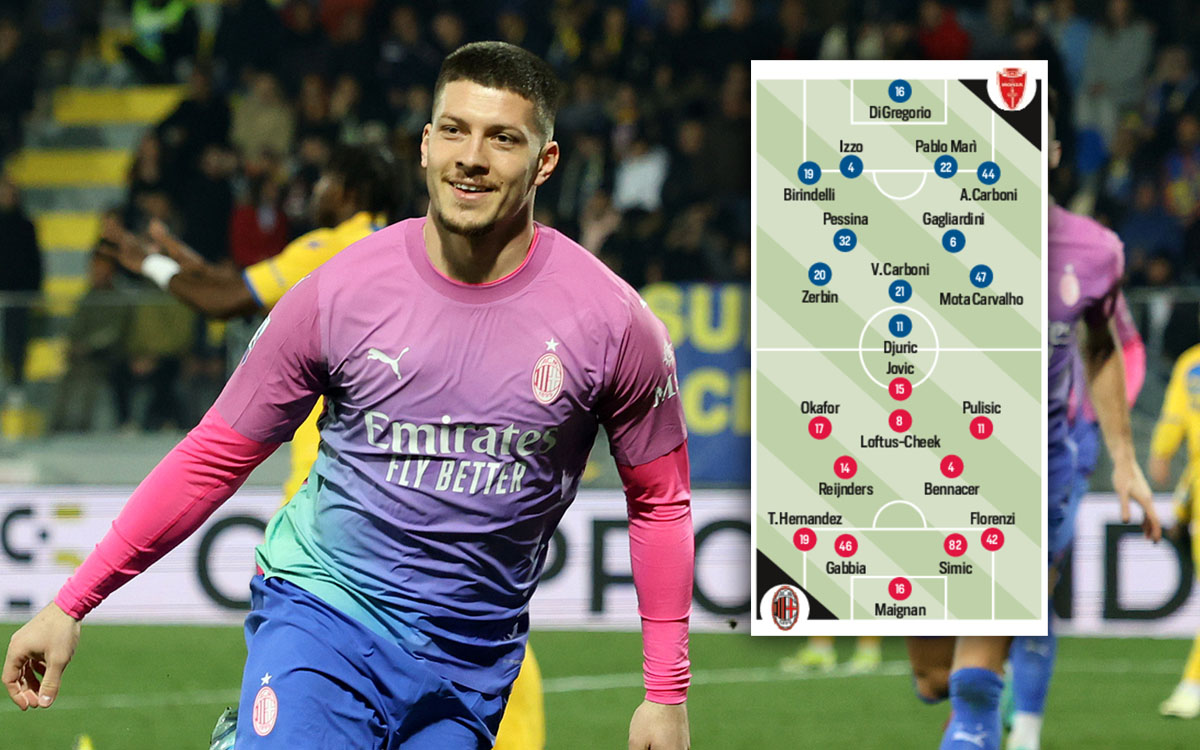
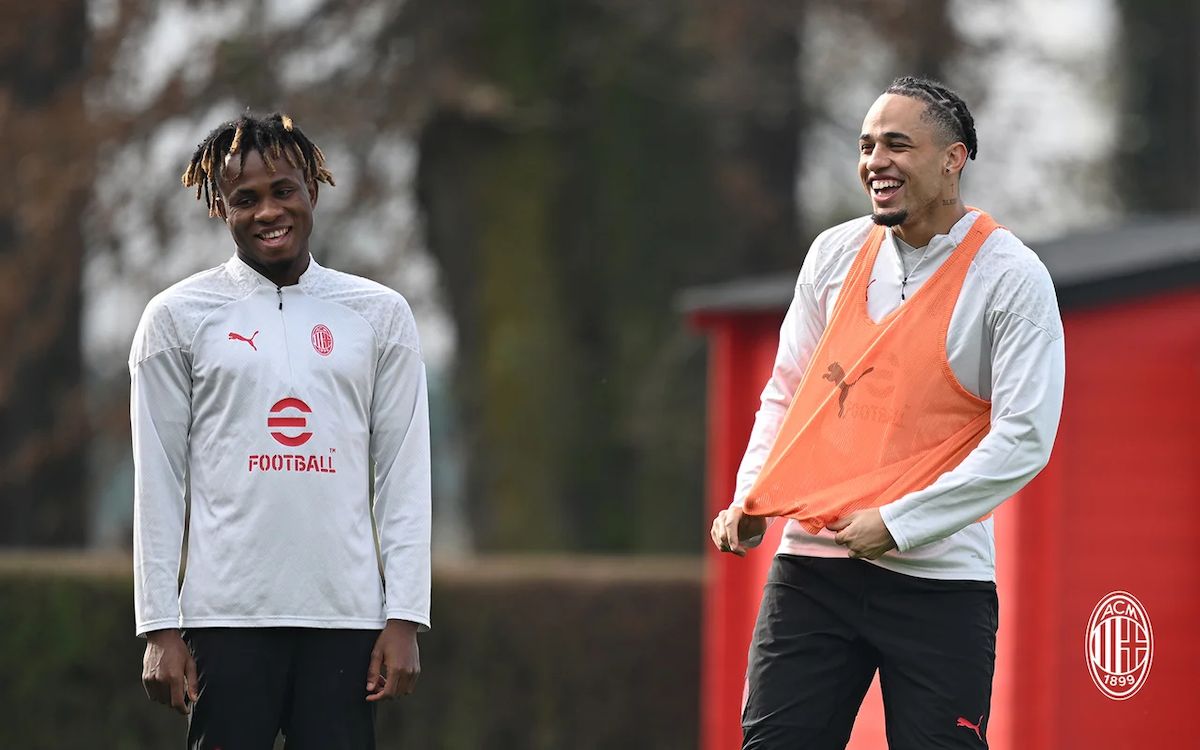
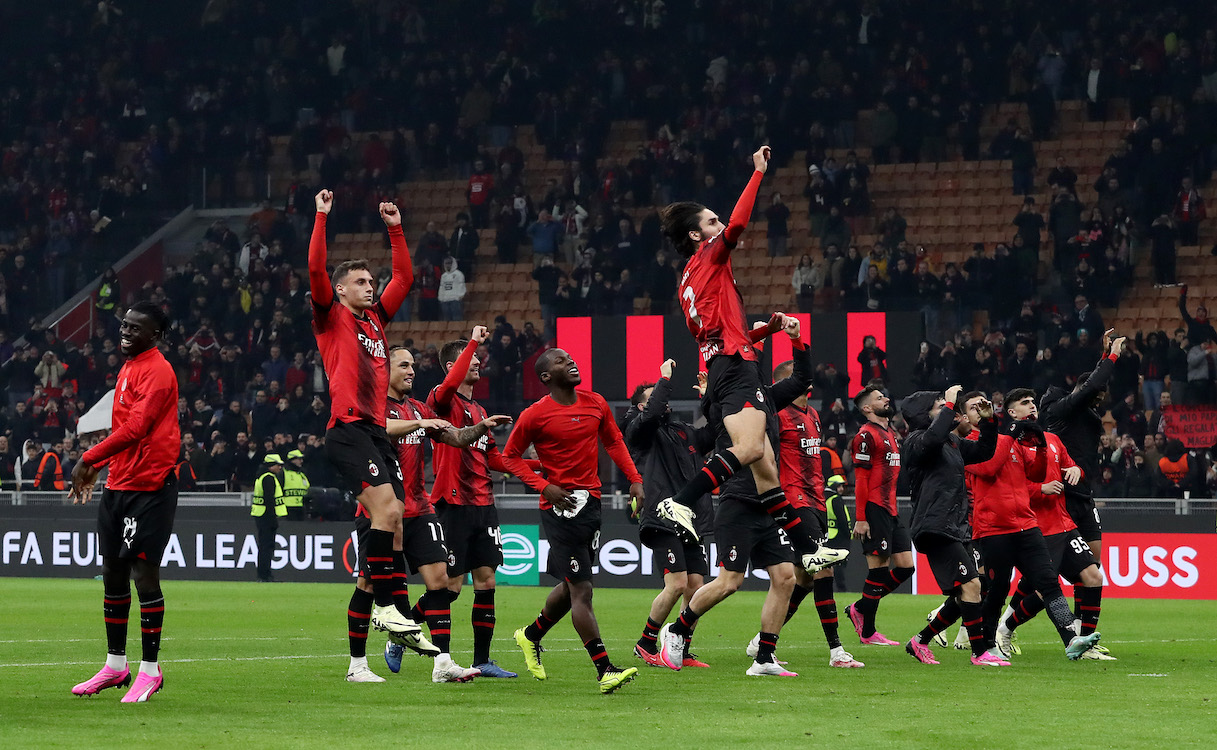


You have my respect for this deep and detailed technical analysis!